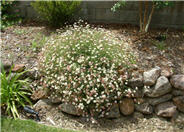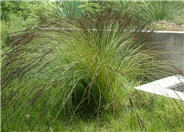
Common name:Common Field or Slender Sedge
Botanical name:Carex praegracilis
This California native grass can tolerate occasional flooding or standing water as it is found in marshes and wetlands. It does make a great lawn substitute as it can be mowed, will take sun and part sun and need watering once a week in hot summer months. This sedge uses much less water than sod. It can be used for erosion control also.

Common name:Mexican Blue or Blue Hesper Palm
Botanical name:Brahea armata
This native to Mexico and Baja California displays a dense canopy of stiff fronds contrasted by graceful inflorescences that arch downward and extend well beyond the foliage.

Common name:Common Yarrow, Mifoil
Botanical name:Achillea millefolium
Common Yarrow is a hardy perennial with hairy, evergreen green foliage. It has a tight cluster of white flowers and typically blooms in the summer months. It attracts bees and butterflies. It prefers full to part sun and becomes drought tolerant once it's established. Following bloom, one should dead head the plant and divide the clumps when it appears crowded to keep it looking tidy.

Common name:Santa Barbara or Mexican Daisy
Botanical name:Erigeron karvinskianus
This low mounding perennial, with fine leaves and white to pinkish daisy-like flowers, is an excellent asset to rock gardens.

Common name:California Buckeye
Botanical name:Aesculus californica 'Canyon Pink'
This Aesculus selection is a tree with a year-round interest. Creamy pink or white flowers bloom in the spring, and when late summer arrives, these leaves drop to unveil pear-shaped fruits. It should be realized that these flowers are
poisonous. The characteristics of this tree are accented by a decorative bark and branch structure. It is commonly found on dry slopes and in canyons below 4000 ft. in woodland communities along the Coast Ranges and Sierra Nevada foothills. - CF

Common name:Coast Redwood, Redwood
Botanical name:Sequoia sempervirens
This fast-growing, aromatic tree has soft, dark green foliage with long needles appearing in flat sprays and brown, barrel-shaped cones that appear after 1 year. Its soft, red-brown bark is fiberous and furrowed. Particularly after mechanical damage, this tree will stump sprout to form new, young trees around the stump. Avoid planting in areas of high foot traffic.

Common name:Small Cape Rush
Botanical name:Chondropetalum tectorum
Chondropetalum tectorum has 3-4' tall stems that shoot out in all directions from the roots. Each stem has papery bracts connected to the ends that turn from tan to dark drown, then fall off. Chondropetalum can grow in marshes, in the ground with regular watering, or in drought conditions.
We can identify at least 11 steps of sustainable landscape renovation for consideration. They include critical design, installation and maintenance practices that conform to good principles of appropriate horticulture.
Click in the green box for more information
Designer: Cornflower Farms
Photographer: GardenSoft
Practice grass-cycling by leaving short grass clippings on lawns after mowing, so that nutrients and organic matter are returned to the soil.
Group plants in your garden according to their water needs (hydrozone).
Develop healthy soil for plants that are vigorous and naturally pest-resistant.